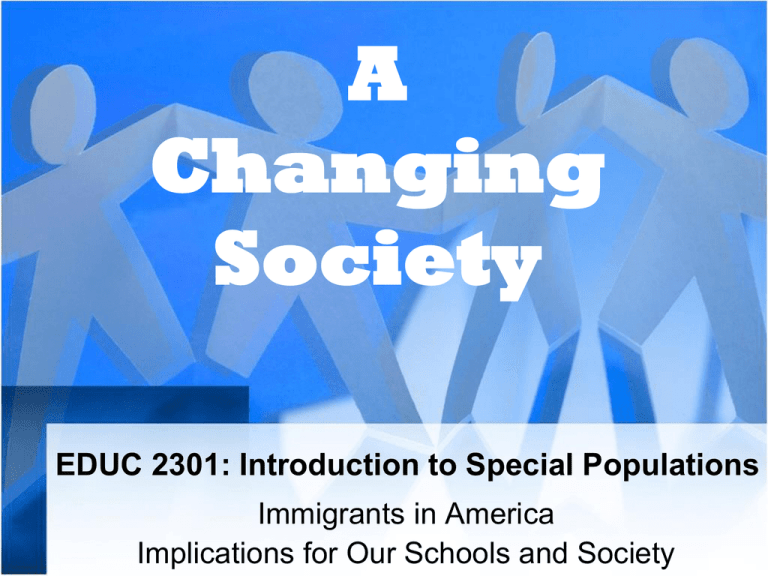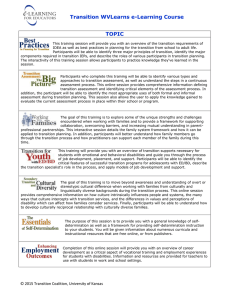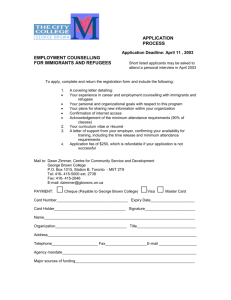A Changing Society EDUC 2301: Introduction to Special Populations
advertisement

A Changing Society EDUC 2301: Introduction to Special Populations Immigrants in America Implications for Our Schools and Society Immigration Eras • Classic Period 1880-1930 – Assimilated by 3rd or 4th generation – 1924 racial restrictions and quotas – 5% of population foreign-born in 1970 • Contemporary Era – Immigration Act 1965, preferences to: • • • • • Family-sponsored Employment-based, Immediate relatives of U.S. citizens Diversity Refugees and asylees Immigrant Diversity • Classic Era – majority from Europe • Contemporary Era – 85% from Asian and Latin populations • 95% of newcomers live in large cities – Dallas, Atlanta, Charlotte, Nashville, Denver, Phoenix, Seattle • Socio-economic Diversity – 60% of foreign-born adults from India, college degrees – Less than 5% from Mexico & El Salvador with college degrees Nation of Diverse Cultures • 22.5 million Legal Permanent Residents – Naturalized Citizens – Refugees – Asylees – Non-immigrant residents (students and temporary workers) • 11.5 Unauthorized Immigrants – California 2.8 million – Texas 1.8 million – Florida 740,000 The Lost Boys of Sudan http://vimeo.com/26288723 Will the New Immigrants Assimilate? • Preserving language and culture – Higher level of residential concentration – Stronger connections to home country – Advances in international travel and communication – Selective assimilation Immigrant Scenarios Group Activity • Read the scenario. • Discuss issues the student might face when he/she first enrolls in school. • List strategies you could use to be a culturally responsive teacher of this student? • What accomodations might be needed? • What guidelines might you use in working with the family of this student? • Be prepared to discuss with class. Guidelines for Working with Culturally Diverse Students • Develop cultural consciousness, aware of your own cultural background. • Develop knowledge of cultural variability and become knowledgeable about how culture influences the teaching/learning process. • Hold high expectations for all students. • Spend time reflecting about teaching practices. • Build trust with students and parents. Working with Linguistically Diverse Students • • • • Work from the students’ knowledge base. Use demonstrations and gestures. Connect concepts and home cultures. Encourage students to share the new vocabulary in their first language. • Pair proficient second language learned with less proficient peers. • Highlight key words, repeat and write them. • Use simple sentence structure. Working with Parents from Diverse Backgrounds • Be inviting and welcoming. • Pronounce names correctly, learn a few words in child’s native language. • Reflect students’ heritage in curriculum. • Show respect to the parents. • Enlist support of translators. • Do your best to provide written communication in the parents’ native language. • Use parents as resources. Implement Culturally Responsive Assessment • Consider testing environment and how it related to students’ prior experiences. • Keep students’ language level in mind. • Implement appropriate accomodations. • Use variety of authentic assessments (checklists, performance tasks, groups) • Provide specific and frequent feedback. • Involve students and families as active participants in the assessment process. Software and Web Resources • Zip Zoom Into English http://teacher.scholastic.com/products/zip zoom/overview.htm • A+ Rise: Research-based Instructional Strategies http://20www.arisek12.com/index.php/sit e/ • Little Explorers Picture Dictionary http://www.enchantedlearning.com/Home .html 60 Second Lesson • Teaching a Concept to a ELL – Draw a picture. – Have students with the same first language explain it in that language. – Re-explain, but simplify the language. – Demonstrate it. – Provide examples and, if necessary, nonexamples (i.e., use of non-examples is typical language used in teaching concepts).




